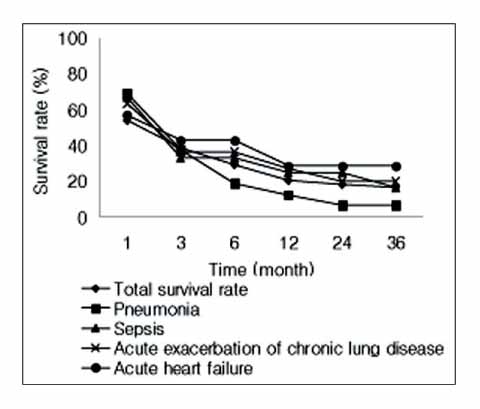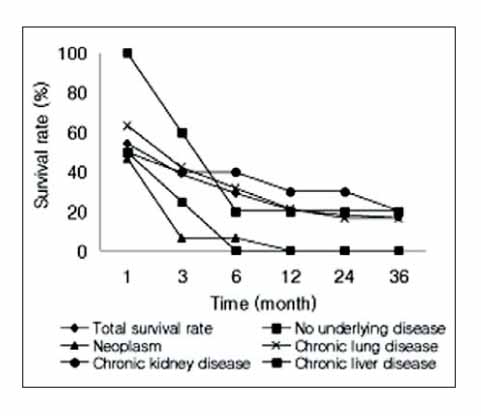Tuberc Respir Dis.
2007 May;62(5):398-405.
The 3 years Prognosis of Patients with Long Term Mechanical Ventilation in Medical Intensive Care Unit at a University Hospital
- Affiliations
-
- 1Division of Pulmonary and Critical Care Medicine, Asan Medical Center, Department of Internal Medicine, University of Ulsan College of Medicine, Seoul, Korea. sbhong@amc.seoul.kr
Abstract
-
BACKGROUND: There is little data on the 3 year prognosis and quality of life of patients on long-term (>72 hour) mechanical ventilation in a medical intensive care unit (MICU).
METHODS
Patients with long-term mechanical ventilation from May 2003 through July 2003 in MICU of Asan Medical Center, Seoul were enrolled in this studay. The survival rates were observed prospectively at 1, 3, 6, 12, 24, 36 months, and the quality of life of survivor was measured at 12 months by using Short Form 36 (SF-36).
RESULTS
The survival rate at 1, 3, 6, 12, 24 and 36 months was 54.8% (40/73), 39.7% (29/73), 30.1% (22/73), 20.5% (15/73), 18.3% (13/71) and 16.9% (12/71), respectively. There was a similar survival rate regardless of the diseases that required mechanical ventilation. A neoplasm or chronic liver disease had a worse survival rate than chronic lung or kidney disease (p>0.05). Each SF-36 domain except for the Role-emotional was inferior to the general population.
CONCLUSIONS
The survival rate of patients with mechanical ventilation more than 72 hours is decreases continuously until 12 months but is relatively constant from 12 to 36 months. In these patients quality of life is also decrased.
MeSH Terms
Figure
Reference
-
1. Knaus WA, Wagner DP, Zimmerman JE, Draper EA. Variations in mortality and length of stay in intensive care units. Ann Intern Med. 1993. 118:753–761.2. Thomsen GE, Morris AH. Incidence of the adult respiratory distress syndrome in the State of Utah. Am J Respir Crit Care Med. 1995. 152:965–971.3. Connors AF, Dawson NV, Thomas C, Harrell FE, Desbiens N, Fulkerson WJ, et al. Outcomes following acute exacerbation of severe chronic obstructive lung disease. Am J Respir Crit Care Med. 1996. 154:959–967.4. Pontoppidan H, Geffin B, Lowenstein E. Acute respiratory failure in the adult. N Engl J Med. 1972. 287:799–806.5. Douglas SL, Daly BJ, Gordon N, Brennan PF. Survival and quality of life: short-term versus long-term ventilator patients. Crit Care Med. 2002. 30:2655–2662.6. Eddleston JM, White P, Guthrie E. Survival, morbidity, and quality of life after discharge from intensive care. Crit Care Med. 2000. 28:2293–2299.7. Djaiani G, Ridley S. Outcome of intensive care in the elderly. Anaesthesia. 1997. 52:1130–1136.8. Hurel D, Loirat P, Saulnier F, Nicolas F, Brivet F. Quality of life 6 months after intensive care: Results of a prospective multicenter study using a generic health status scale and a satisfaction scale. Intensive Care Med. 1997. 23:331–337.9. Konopad E, Noseworthy TW, Johnston R, Shustack A, Grace M. Quality of life measures before and one year after admission to an intensive care unit. Crit Care Med. 1995. 23:1653–1659.10. Dragsted L, Qvist J, Madsen M. Outcome from intensive care. IV. A 5-year study of 1308 patients: long-term outcome. Eur J Anaesthesiol. 1990. 7:51–62.11. Heyland DK, Cook DJ, Griffith L, Keenan SP, Brun-Buisson C. The attributable morbidity and mortality of ventilator associated pneumonia in the critically ill patients. Am J Respir Crit Care Med. 1999. 159:1249–1256.12. Angus DC, Linde-Zwirble WT, Lidicker J, Clermont G, Carcillo J, Pinsky MR. Epidemiology of severe sepsis in the United States: Analysis of incidence, outcome, and associated costs of care. Crit Care Med. 2001. 29:1303–1310.13. Vincent JL, Sakr Y, Ranieri VM. Epidemiology and outcome of acute respiratory failure in intensive care unit patients. Crit Care Med. 2003. 31:S296–S299.14. Nam BH, Lee SW. Testing the validity of the Korean SF-36 health survey. J Korean Soc Health Stat. 2003. 28:3–24.15. Ware JE. SF-36 health survey. Manual & Interpretation Guide. 1993. Boston, MA: Quality Metric, Inc..16. Cha BS, Koh SB, Chang SJ, Park JK, Kang MG. The assessment of worker's health status by SF-36. Korean J Occup Med. 1998. 10:9–19.17. Herridge MS, Cheung AM, Tansey CM, Matte-Martyn A, Diaz-Granados N, Al-Saidi F, et al. One year outcomes in survivors of the acute respiratory distress syndrome. N Engl J Med. 2003. 348:683–693.18. Davidson TA, Caldwell ES, Curtis JR, Hudson LD, Steinberg KP. Reduced quality of life in survivors of acute respiratory distress syndrome compared with critically ill control patients. JAMA. 1999. 281:354–360.19. Chatila W, Kreimer D, Criner G. Quality of life in survivors of prolonged mechanical ventilatory support. Crit Care Med. 2001. 29:737–742.20. Niskanen M, Ruokonen E, Takala J, Rissanen P, Kari A. Quality of life after prolonged intensive care. Crit Care Med. 1999. 27:1132–1139.21. Engoren M, Buderer NF, Zacharias A. Long term survival and health status after prolonged mechanical ventilation after cardiac surgery. Crit Care Med. 2000. 28:2742–2749.22. Garratt A, Schmidt L, Mackintosh A, Fitzpatrick R. Quality of life measurement: bibliographic study of patient assessed health outcome measures. BMJ. 2002. 324:1417–1421.23. Chrispin PS, Scotton H, Rodgers J, Lloyd D, Ridley SA. Short Form 36 in the intensive care unit: Assessment of acceptability, reliability and validity of the questionnaire. Anaesthesia. 1997. 52:15–23.24. Ware JE, Sherbourne CD. The MOS 36-Item Short-Form Health Survey (SF-36). I. Conceptual framework and item selection. Med Care. 1992. 30:473–483.25. McHorney CA, Ware JE, Raczek AE. The MOS 36-Item Short-Form Health Survey (SF-36). II. Psychometric and clinical tests of validity in measuring physical and mental health constructs. Med Care. 1993. 31:247–263.
- Full Text Links
- Actions
-
Cited
- CITED
-
- Close
- Share
- Similar articles
-
- Clinical Characteristics and Prognosis of Elderly Patients Receiving Prolonged Mechanical Ventilation in the Medical Intensive Care Unit at a University Hospital
- Monitoring and Interpretation of Mechanical Ventilator Waveform in the Neuro-Intensive Care Unit
- Outcomes of patients with COPD requring mechanical ventilation
- Prevention and Management of Ventilator-Associated Pneumonia
- Clinical Characteristics and Prognosis of Patients with Intracranial Hemorrhage during Mechanical Ventilation



